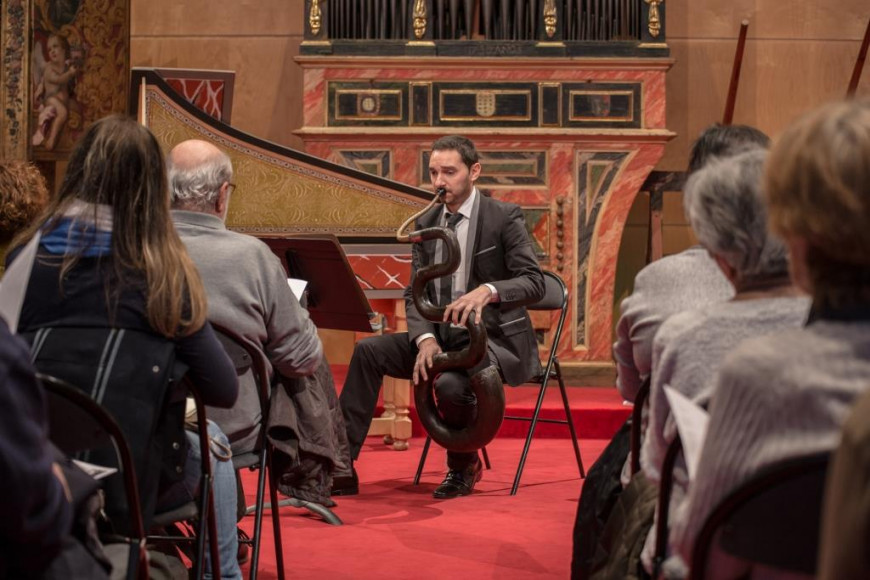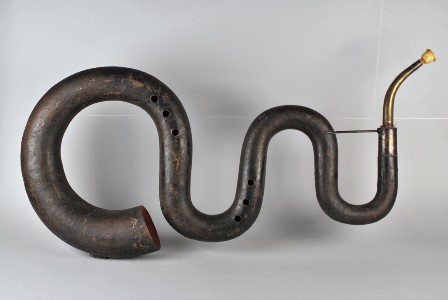
News
The serpent: notes on terminology
Following the extraordinary concert performed by Pablo Dopazo at the Museu de la Música with this instrument (21 January 2018)—six of which we have in our collection—we received some enquiries about its name: the serpent. Since this is of interest from a musical terminology point of view and is, in our opinion, something that has not been dealt with properly with regard to the Catalan language, I decided to write about the reasons behind the name and the data that support it.
According to the research, the instrument was invented in Auxerre, Burgundy, in 1592 by Edmé Guillaume. Apart from its use to support the bass singers in religious song, we don’t have any other details regarding its use or morphology. We have only kept the French name serpent, which refers directly to the instrument’s snake-like shape (the animal is also called serpent in French). In French, this was practically the only name it had during the two and a half centuries that it formed part of church and military band music. In English, the French name was maintained, adapting the pronunciation and changing the accented syllable (serpent), and had nothing to do with the name of the animal (snake). The case was the same for German, Dutch and Russian.
In the other Latin languages, however, the name was related to the large size of the imaginary reptile, with the name taking the augmentative form: this must have happened first with Occitan, where the augmentative serpent is used instead of sèrp for the animal; in Italian it takes the name serpentone, the augmentative form of the name of the animal (serpente). Following the Italian form—probably very strong in the world of musicians—in Spanish it is called serpentón (the augmentative of serpiente) and in Portuguese serpentão (in relation to serpente).
So, what do we know about the Catalan name? Well, the scores and descriptions from the 17th, 18th and 19th centuries often mix up the Catalan and Spanish names, as happened in all the writings from these centuries: we find some written examples of serpent and others of serpenton. The form serpan (which we understand to be accented on the second syllable, despite appearing in a Spanish-language work), written by Pere Rabassa in Guia Para los Principiantes que dessean Perfeycionarse en la Compossicion de la Mussica (Guide for Beginners Wishing to Improve in Musical Composition) (1726), is revealing: it seems to be inspired by the French word, but is very close to the Catalan word serpent and far from the Spanish language in which the treatise is written, where it would be serpentón.
Nonetheless, in the documents there is not a single mention of serpentó. Why not? Because in Catalan word-formation, the suffix -ó usually designates a smaller object or thing: carreró (alleyway), botifarró (small blood sausage), mamelló (suckling pig) and guitarró (small, traditional guitar from the Balearics and Valencia) (hence the paradox with the Spanish guitarrón, which refers to a bigger version of the guitar!). If we take a quick look at Alcover and Moll’s Diccionari Català-Valencià-Balear (Catalan-Valencian-Balearic Dictionary), we immediately see that the augmentative form of serp in Catalan is the masculine serpent (exactly as we saw in Occitan), together with serpassa or serpota. Serpent is defined as ‘Dragon, an imaginary animal that the populace considered to be the evolution of an ordinary snake that has grown a great deal’. It then adds another meaning, which is the one that interests us: ‘Instrument that is a variant of the horn, but with a very wavy snake-like shape; Spanish serpentón.’ There is no entry for serpenton or serpentó... Serpentó would be, if anything, a diminutive: a very small snake.
So where does the use of the name serpentó in Catalan originate from then, to refer to this large instrument? It is nothing more than a calque, a quick and clumsy Catalanisation of the Italian serpentone and/or Spanish serpentón, which some musicians must have heard in international exchanges. Based on this use, it appeared in some works that aimed to establish rules, such as the Gran Enciclopèdia de la Música (Great Encyclopaedia of Music). This dictionary must have been the reference for blindly introducing the word both in the Diccionari descriptiu de la llengua catalana (Descriptive Dictionary of the Catalan Language) (which has both serpent and serpentó for the instrument) and in the Diccionari de la llengua catalana de l’IEC, 2 (Dictionary of the Catalan Language of the Institute of Catalan Studies, 2), where only serpentó appears (‘Woodwind instrument with mouthpiece and nine holes, curved in an S shape’). Termcat’s Instruments musicals (vocabulari il·ustrat) (Musical instruments (illustrated vocabulary)), initially included serpentó, which is now under serpent.

At the Museu de la Música de Barcelona, we spent months going back and forth trying to choose an option, but once all the data had been analysed and considered a second time, we thought it was necessary to decisively go for serpent, especially considering the minimal involvement of professionals who play this instrument in Spain (fewer than half a dozen, none of whom play it exclusively) and that our work as a museum also includes standardising musical terminology, especially regarding instruments. This is why, when including this instrument in a solo performance for the first time in our programme (something surely unprecedented in the last 200 years), we used the name serpent. Following the same logic, the instrumentalist will have to be called a serpentista (serpentist in English, serpentiste in French—in 18th and 19th-century treatises—and serpentonista in Spanish and Italian, also from the 18th century).
Language / Animal / Instrument
French / serpent / serpent
English / snake (serpent) / serpent
German / schlangen / serpent (schlangenrohr)
Dutch / slangen / serpent
Russian / Зме́и / Серпент (serpent)
Occitan / sèrp / serpent
Catalan / serp / serpent (‘serpentó’)
Italian / serpente / serpentone
Spanish / serpiente / serpentón
Portuguese / serpente / serpentão

